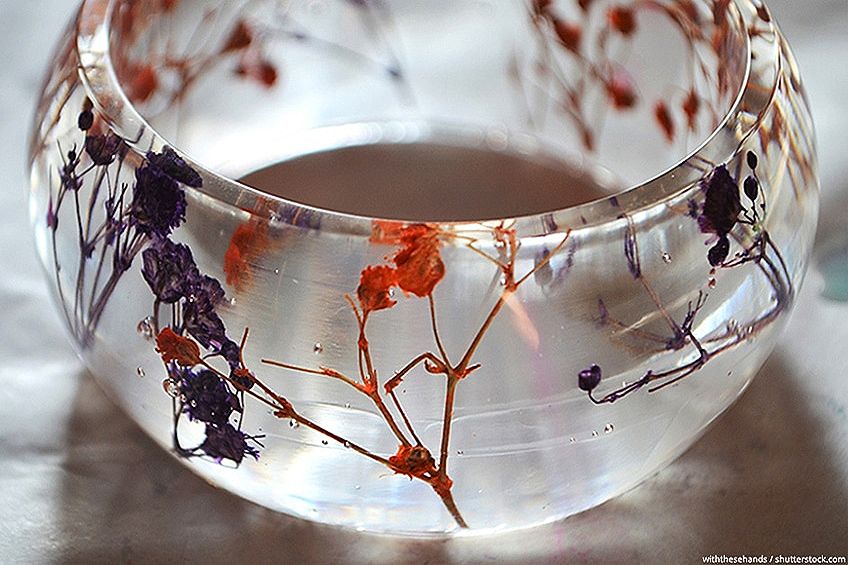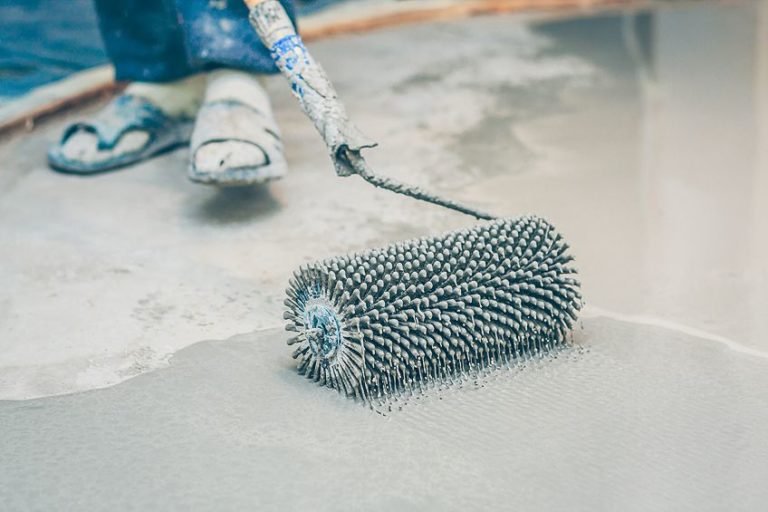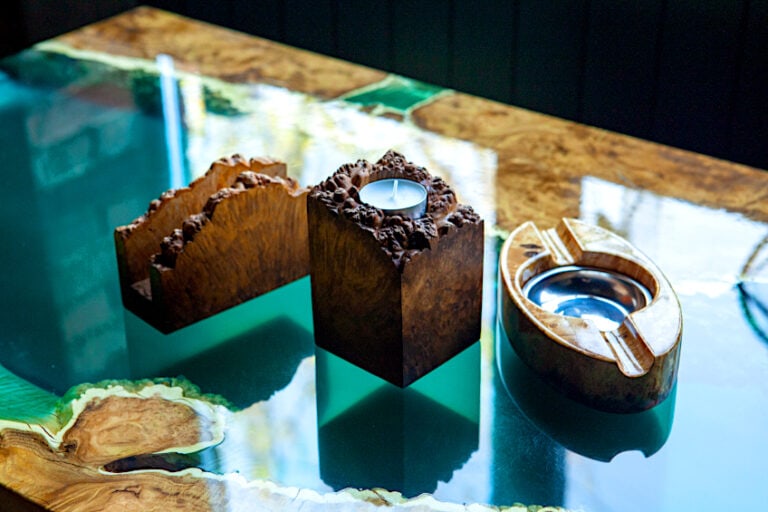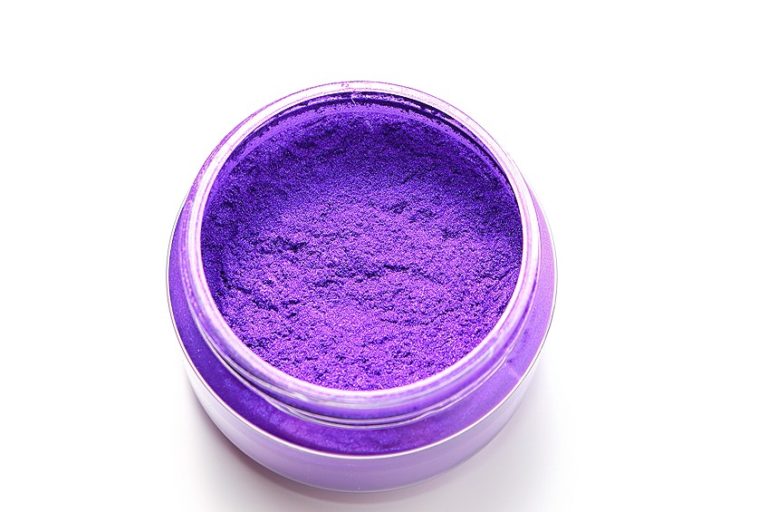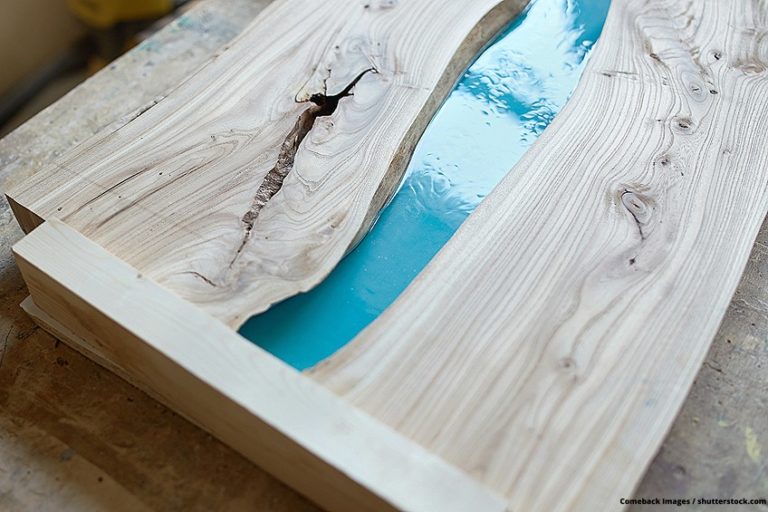Preserving Flowers in Resin – How to Cast Fresh Flowers in Resin
This post may contain affiliate links. We may earn a commission from purchases made through them, at no additional cost to you.
Flowers are some of nature’s most beautiful assets, and can be enjoyed planted, picked, fresh, and dry. As flowers do not live forever, it is a good idea to preserve them so that you can enjoy them for many years to come. To preserve flowers, you simply need to dry them and then cast them in epoxy resin, all of which we will instruct you on how to do below.
Different Uses for Dried Flowers
Dried flowers can be used for the following applications, to name a few:
- You can use dried flowers when making unique gifts, or cards.
- Dried flowers are incorporated in several different teas.
- You can take advantage of their pleasant aroma by putting them in sachets and keeping them in your drawers.
- A variety of different beauty products make use of dried flowers.
- You can mold dried flowers into a wax so as to create unique candles.
While the above illustrates how versatile dried flowers are, we will be focusing on anadditional use in this article, which is how to preserve dried flowers in resin. The following are a few options of how one might choose to preserve their dried flowers in resin:
- Botanical Coasters – Dried flowers preserved in resin in the form of a coaster make wonderful gifts and provide a floral touch to your décor.
- Wedding Bouquets – Your wedding day is one of the happiest days of your life, and your wedding bouquet is something that is an important part of your big day. Many people choose to preserve their wedding bouquet in resin so as to preserve the memory.
- Jewelry – There is an assortment of ways in which you can use dried flowers in resin jewelry, such as in rings, necklaces, pendants, bracelets, and so on.
- Cellphone Cover – You can use dried flowers to create a unique back cover for your cell phone.
- Picture Stands – Preserve dried flowers in resin to create a stunning picture stand or a picture frame that you can hang on the wall.
- Flowerpot Holders – You can elevate the look of your flowerpot holders by encasing them with resin and incorporating dried flowers.
- Sun-Catchers, Paper Weights, and Wind Chimes – These are other items that can be elevated compeltely by adding dried flowers to the resin.

Real Flowers versus Artificial Flowers
There are two different kinds of flowers you can use, being artificial (fake) flowers, and real flowers. If you are using real flowers, you will have to ensure that they are completely dried before using them in the resin. You can choose either to dry the flowers yourself, or you can purchase pre-dried flower sets online.
Artificial Flowers
You will find artificial flowers readily available at your local florist or at any local house and home store. From these establishments, you will be able to purchase exactly what you require, and the quantity needed. These flowers are ready to be used for your project immmediately as they do not need to be dried. You can also purchase artificial flower packs from online suppliers like Etsy, Amazon, and others, but you will have to accept the quantity on offer and will often end up purchasing additional flowers that you do not require.
Real Dried Flowers Bought Online
You can purchase real dried flowers from your local florists, which allows you the option to select the types of flowers you require and how many of each. An alternative is for you to buy your real dried flowers online, from the likes of Etsy, Amazon, and other specialist suppliers. The negative of purchasing your dried flowers online is that you usually are only able to purchase bunches of a variety of flowers, which may include flowers you are not looking to use.
Dry Your Own Flowers
This is a great option as an alternative to buying real dried flowers. It allows you to select the fresh flowers, and how many of each type you require. You can then dry them at home to use in your resin project.
How to Dry Your Own Flowers
People have been drying their leaves and flowers for years, as it is a simple process that allows you to preserve the beauty of each item for years to come. There are a few different methods you can use to dry your flowers.
Pressing the Flowers in a Book
To press the flowers, you can use either a flower press or a large, heavy book, either of which will assist in flattening your flowers.
We suggest using this method if you are working with flowers that have thin petals, such as geraniums, gladioli, pansies, poppies, delphiniums, and so on.

- To begin, you have to pick the flowers you wish to use. It is important to only pick flowers once the dew has dried for the day. You can pick the flowers at any stage of blooming, from bud stage to fully open. You can also include the leaves if you want.
- You need to press the flowers immediately and ensure they have not begun to wilt. Place the flowers carefully in the book between two sheets of absorbent paper (such as paper towel). The absorbent paper will protect the pages of your book from any staining or moisture. If you have chosen to use a flower press as opposed to a book, you can use two sheets of smooth paper.
- The length of time required to dry the flowers is dependent on which flowers you have chosen to use. Rather leave them for longer so to ensure that they are completely dried. To be on the safe side, leave them for at least 3 to 4 weeks.
Once your flowers have completely dried out, they are ready to be used in all of your projects. This can be anything you wish to undertake, such as casting them in resin, attaching them to letters and cards, decorating cakes, and so on.
Pros
- Drying your flowers this way is a simple and cheap option.
- Once dried, your flowers can be used for an assortment of projects.
- This is an easy method to do and is one that anyone can master. You will not require any special equipment or items.
- This method leaves your flowers flat, beautiful, and long-lasting.
Cons
- If moisture gets to the flowers, they can become moldy as opposed to drying out.
- It is a very long method that can take as long as 4 weeks to finish.
- While you have preserved the flowers, they will be flat.
- Drying your flowers with this method leaves the flowers very delicate and brittle. They need to be handled with care as they can break very easily.
- Through drying your flowers out with this method, you will lose out on a lot of the vibrancy in the colors of the flowers.
Drying Your Flowers in Silica Gel, Sand, and Borax
Using sand, silica gel, or borax powder to dry out your flowers is a quick option. When selecting which flowers you are planning to dry out, we recommend that you pick your flower prior to them completely opening.
This method is ideal for delicate flowers such as lilies.
Next, you need to select the material with which you will dry the flowers; the options are as follows:
- Fine Sand: While slow to do, this method is cheap and readily available for most. You will not be covering your flowers with sand, as you may think. Instead, you will carefully position your flowers on top of the sand, allowing the sand to support them, and then leaving the flowers to air-dry.
- White Corn Starch and Borax: Another affordable option, this method requires a mixture of 6 parts of corn starch with 1 part of borax.
- Silica Sand or Silica Gel: This is the quickest option and is also quite cheap to do, as you can purchase the silica gel or sand from any local supply store. What is great is you can use the product over and over again.

The container that you use is dependent on which of the above substances you select. You will need a strong enough container when working with either sand or borax, and if you have chosen to use silica gel or sand you will need to use a container that seals airtight. Once you have the relevant container, proceed as follows:
- Pour about 1 to 2 inches of silica sand or gel (roughly 2.5 to 5 cm) into the relevant container.
- Carefully place your flowers in the silica so that they are standing in an upright position. There are certain flowers, however, that may actually dry better if they are lying down on the silica, such as delphiniums and snapdragons.
- Once you have placed the flowers in the poured silica, you can completely cover the flowers in silica. Be sure to pour the silica carefully.
- Place your container in an area that is dry and warm, and allow the flowers to dry.
- Silica dries flowers in 2 to 4 days. The silica turning a pink color is an indication that all the moisture has been absorbed, and that the flowers are dry.
- If you have chosen to use borax instead of silica, it can take anywhere between 5 to 14 days to dry your flowers. Sand can take even longer, and can take as long as 21 days.
- Once your flowers have been allowed sufficient time to dry, you can remove them from the material you have chosen to use.
- Use a small brush to dust off any residual substance from the flowers, and then spray the flowers with hairspray to stop them from breaking.
Pros
- Using any of the above substances will ensure that you do not lose any of the colors from your flowers.
- All of the above methods are cheap and easy to do.
- These are your fastest options for drying flowers.
- These substances allow you to preserve a flower in its entirety.
Cons
- Pouring the substance too quickly over the flowers can damage them.
Hanging Your Flowers Up to Dry
Hanging your flowers up to dry is the simplest method to use, although it does take a long time. This method requires some preparation in terms of cutting the stems of the flowers and removing any leaves, after which you will need to tie a string or band around the stems.
This method is a great option for if you are looking to dry out whole bouquets as well as smaller, more delicate flowers such as lavender. It can also be a good method for more robust flowers such as roses.
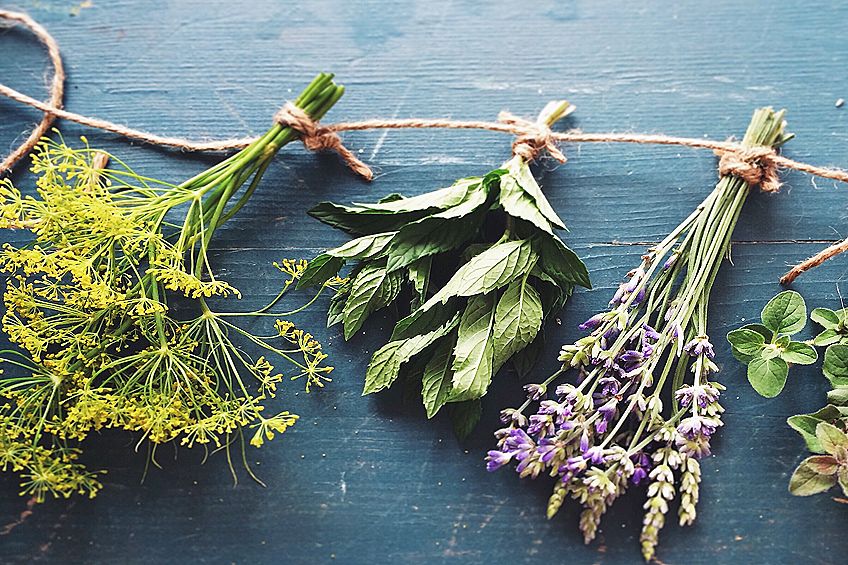
- You will need to remove all the leaves from the stems and shorten the stems to roughly 6-inches-long. The sooner you begin the drying process, the more vibrant the color will be at the end.
- You can then tie a piece of string or a rubber band around the stems of each flower. If you are working with a bouquet, tie it around the stems of all the flowers of the bouquet.
- You can now hang up the flowers by attaching the rubber band or string to a rod or coat hanger, hanging the flowers upside down to allow them to dry. Ensure that there is sufficient ventilation in the area where you hang your flowers
- It will take roughly 3 weeks for the flowers to dry completely. Once they have been allowed to dry, you can spray them with an unscented hairspray so as to protect them.
Pros
- This method will not cost you anything and is very easy to do.
- You will be able to preserve the flower as a whole with this method, and not simply the petals.
- Once dried, the flowers will be able to last for years.
- You will be able to preserve the stunning colors of the flowers.
- If you are drying a bouquet, you can preserve the whole bouquet, as opposed to individual flowers.
Cons
- You will not be able to use this method for orchids, as they will lose their color and will take too long to dry.
- The method takes a long time, anywhere from 3 to 4 weeks.
- If you wait too long to begin the process, there is a chance that you will not be able to preserve the vibrant colors of the flowers.
- Some flowers such as roses may shrink during the process.
- Once dried, the flowers become brittle and can break easily.
Microwave Flower Press
To use this method, you will require some coffee filters, two flat microwave-safe ceramic plates, and of course, a microwave.
- You will need to arrange the items as follows: First, a plate face-up, followed by a coffee filter. You then place your flowers on the coffee filter and place another coffee filter on top. Lastly, place the final plate, also face-up.
- Put the pile of items carefully in the microwave for one minute, and then remove them from the microwave.
- Have a look at how dried your flowers are, and then replace the coffee filters and microwave everything again for another minute.
- You can continue this process until your flowers are completely dried.
Microwave with Silica Gel
This method is another option for someone who is looking for quick results. Both this method and the other microwave method are very safe, as the moisture in the flowers is heated up by the microwave, allowing the vapors to escape, resulting in the flowers drying out.
This type of drying method is ideal for pale-colored and white flowers, and is great for drying daisies and roses.
This method requires a microwave, silica gel, and a microwave-safe container. The silica gel is available from most craft stores and can be used more than once, and will aid in keeping the shape of the flowers. Ideally, you want a microwave-safe container that is not too large to fit in your microwave but is still big enough to hold the flowers.
- Pour roughly 1 to 2 inches of silica gel at the bottom of the container, and then arrange the flowers in the gel, ensuring that the blossoms are facing up. Pour additional silica gel on top of the flowers, but be careful not to damage the flowers as you pour. Ensure that you cover the petals completely.
- Place the container, without the lid on, in the microwave and set the necessary temperature. Not all flowers dry at the same pace, so it will be necessary for you to test out the method to determine the ideal time for the flowers you have selected. Try setting your microwave for 2 to 5 minutes, at a temperature roughly 2 levels higher than defrost, and then increase the temperature as necessary.
- When you are certain that the flowers have dried out, open the microwave and immediately cover the container with its lid. Allow the lid to be open just slightly in one corner, and leave the container for roughly 24 hours.
- After 24 hours, you can remove the flowers from the gel and gently clean off any residual gel with a fine brush. Then, spray them with an acrylic spray so as to ensure that they are preserved for longer.
Be careful when performing this method, as the silica gel gets very hot. Thus, you should not remove the container from the microwave until it has sufficiently cooled.
Pros
- These are fast methods, as they allow you to dry your flowers within minutes.
Cons
- There is a chance that you may destroy your flowers by overheating them, as not all flowers dry at the same temperature.
Required Materials for Using Flowers in Resin
You will need a variety of materials should you wish to use flowers in resin. You will require:
- A good-quality casting resin;
- A silicone mold;
- Dried flowers;
- Measuring cups;
- Popsicle or craft sticks for mixing;
- Toothpicks and a hairdryer for removing bubbles;
- Fine-grit sandpaper in grit sizes 150, 200, 400, 1000, and 3000;
- A plastic drop cloth to protect your surfaces from any resin which may spill over.
- And suitable safety gear (nitrile gloves, a respirator, and safety goggles).
Best Resin for Preserving Flowers
There are a variety of different resins available to purchase, and selecting the best one for your particular project will have a large impact on the results. You need a resin that will ensure a high-gloss, durable finish, and ideally one that is non-toxic, non-flammable, and has a low odor. A self-leveling resin will also aid you with your projects.
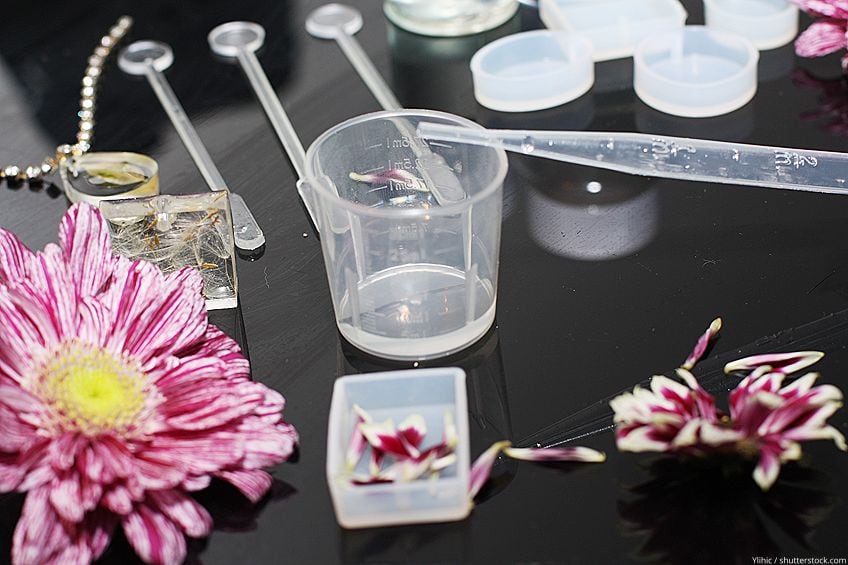
PROMARINE SUPPLIES ProArt Epoxy Resin
This resin is simple to use as long as you follow the necessary 1:1 mixing ratio. When set, it gives a hard finish. This resin is ideal for smaller molds, providing optimal hardness and protection. The resin also very rarely forms air bubbles. It is designed to be used for art projects and offers the user great color stability. Once cured, it is crystal-clear and has high gloss finish.
Pros
- This is a premium-quality non-toxic resin.
- The resin has a self-levelling formula.
- This product is UV-resistant.
- The finish offers a high gloss and intense shine.
- There is a simple 1:1 mixing ratio.
Cons
- The resin has a long curing time.
INCREDIBLE SOLUTIONS Deep Pour Clear Casting Resin
This resin is ideal for working with larger molds, as you do not want too much heat to be produced during the curing process. This resin is also ideal for outdoor projects, as it has UV inhibitors that stop it from yellowing. This resin requires a 2:1 mixing ration (by volume). It gives crystal-clear results and works well with dyes and pigments. The resin has a long working time and a low viscosity.
- Thick pours, low viscosity, and long working time
- Clear results and compatible with pigments and dyes
- 2:1 mixing ratio by volume
Pros
- This product mixes well with mica pigment powders. Otherwise, it cures to a crystal-clear finish.
- The resin has a low exothermic rate, allowing for a longer working time.
- This resin will hardly shrink upon curing.
- This product is UV-resistant so as to prevent yellowing.
Cons
- This product is expensive.
Molds
The majority of resin projects will require the use of a mold. Your best option is a silicone mold which can be purchased in several different shapes and sizes.
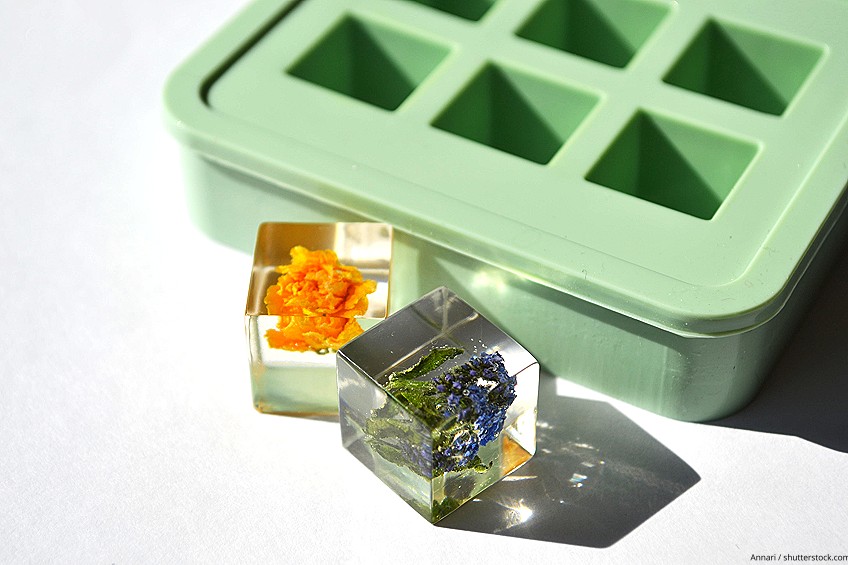
EUTENGHAO Silicone Resin Casting Molds
The set is made up of 18 pieces, including 10 wooden sticks, two measuring cups, and silicone molds in the shapes of a sphere, two different crystal stones, a diamond, a cube, and a triangular pyramid. These molds have smooth and shiny interiors so as to reduce your need to polish the resin once cured. It is recommended that you use release spray in order to extend the length of your mold’s life. These molds are not easily damaged and can be cleaned with ease. They are very flexible pieces.
Pros
- The set includes many molds of interesting shapes.
- The molds are easy to release.
- The interiors of the molds are shiny and smooth, resulting in a more polished finish to your cured resin.
- You can use these molds for a wide range of projects, including those of epoxy resin, soap, and wax.
- These molds are sturdy and durable.
Cons
- The molds are smaller than expected.
Dried Flowers
It is important to ensure that your flowers are completely dried before you use them. While many people like to dry their own flowers, you can also purchase a set of dried flowers online.
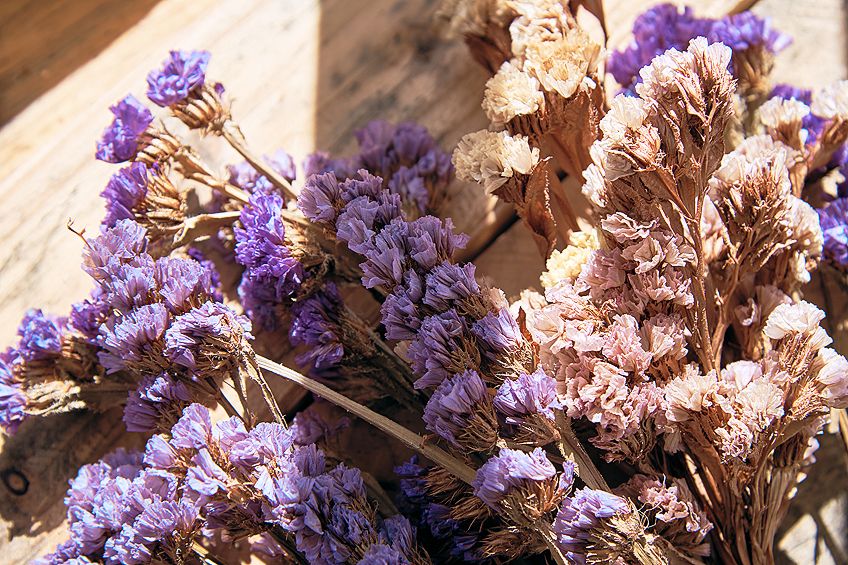
NUANCHU Real Dried Pressed Flowers
This set includes 68 pieces of pressed dried flowers and leaves, as well as a pair of curved tweezers to allow for precise and delicate working. The pieces are all varied in shape, style, and color, providing you the choice to make all kinds of designs. These natural pieces are vacuum sealed in a transparent packaging so as to preserve their freshness. You can use these dried flowers and leaves for many different projects, from being cast in resin to using them in jewelry or scrapbooking; the options are endless.
- Wide range of natural dried flowers and leaves
- Set includes a pair of tweezers for precision
- Flowers are vacuum sealed for protection
Pros
- This set includes a wide range of different leaves and flowers.
- This particular product includes a pair of tweezers to help you handle the flowers.
- The flowers are vacuum sealed into a transparent package for protection.
- These pieces are more durable than most dried flowers and plants, although they are still fragile.
Cons
- The pieces are really small.
How to Preserve Flowers in Resin
Now that your flowers have dried completely, they ready to be preserved in resin. By embedding items in resin, you will be able to preserve them for a very long time. There are a number of steps involved in this process, each of which we will go through in detail.

Mixing the Resin
Ensure that you have everything you need at hand, whilst also ensuring that you have protected yourself accordingly by wearing safety goggles, nitrile gloves, and a mask or a respirator. We suggest that you use a clear resin, as this will allow you to see the flowers clearly once the resin has cured.
If you are unsure about the quantity of resin that you need to mix, you can follow the guideline that a 12×12-inch container will require 2.5 ounces of resin and 2.5 ounces of hardener.
- Using paper or plastic cups, begin by mixing the resin with popsicle or craft sticks to stir. Always consult the manufacturer’s instructions when mixing resin. Usually, you will receive the casting resin in two-parts, which then need to be combined using a 1:1 ratio (1-part hardener to 1-part resin). But be careful, as some brands call for a 2:1 ratio, so following the instructions is imperative.
Should the mixture not be correct, you may find that the resin never fully cures and will remain sticky. The set resin can also be brittle and will break with ease.
- Mix the combination for at least 3 to 4 minutes (roughly 200 revolutions) to ensure that the two parts have been combined thoroughly.
- Once you have mixed the resin, allow it to sit for a minute or so, which will give the bubbles a chance to rise to the surface. You can use a heat gun, a hair dryer, or a toothpick to aid in removing any remaining bubbles.
Pour the Base and Place the Flowers
Ensure that you clean your mold before use, as you do not want any dirt or dust in it. You will have plenty of time with which to work with the resin before it begins to cure, which means that you can work slowly and carefully.
- Place the mold flat on your work surface and ensure that it is level. Slowly pour in the first layer of resin into your mold, allowing it to cover the whole bottom area of the mold.
- We suggest pouring more than one layer, depending on how thick you wish your finished item to be or how deep the mold itself is. Two layers will allow your flowers to be preserved in the middle of the resin, creating a floating effect. Ensure that any air bubbles are removed using either your heat gun or a toothpick.
- It is now time to place your flowers in the first layer of resin. It is imperative that the flowers are completely dry, as any moisture will cause the flowers to turn brown. Place them carefully on top of the resin and, with the help of a popsicle stick or some tweezers, position them how you want them. As the bottom of the mold will end up being the top of your finished product, be sure to place the flowers face down into the mold.

- Ensure that there are no air bubbles that have formed under the flowers or petals. If there are any, you will need to remove them. Keep an eye on the resin, watching that your flowers do not move or shift while allowing the initial layer to set.
- Always consult your resin’s manufacturer’s instructions before applying the next layer of resin, as some resins require you to begin pouring the second layer before the first layer has cured. When you are certain that the flowers are set in place, allow the first layer of resin to dry for approximately 24 hours.
- Once the initial layer has either dried or is tacky to the touch (depending on the manufacturer’s directions), you can add the top layer of resin. Make sure that you completely cover the flowers and fill the whole mold up with resin.

Curing and Finishing
Allow your resin to cure completely. The resin will be dry to the touch after about 24 hours, depending on which brand you use, but you should allow at least 48 to 72 hours for the resin to cure entirely.
- Once the resin has completely cured, you can take it out of your mold. If you find that it is still flexible at this stage, level it out and allow it additional time to cure properly and become hard.
- Finally, you will have to clean and finish off your resin flowers. You may find that your resin flowers are slightly rough around the edges and along the back. You can remove these edges by using fine sandpaper. You can avoid this step by using polished silicone molds, as these will cause your resin to look smooth and shiny upon removal.
- After sanding, apply a polishing paste to your reisn flowers to add an extra, final shine.

Tricks and Tips
What follows are a few tricks and tips to assist you when tackling dried flowers in resin for the first time.
- The most important element of resin is to ensure that you mix the correct proportions of the two components. If you do not use the correct measurements, your resin will not cure correctly. Ensure tthat you use a special stirring cup that has the exact measurements you require.
- You can remove any air bubbles by using a heat gun or a toothpick. An alternative option is to use a drinking straw and gently blow over the resin, which aids in removing the bubbles.
- While professional-grade resin states that it is non-toxic, you should always take your health and safety into consideration. When you are processing resin, toxic fumes can develop. It is highly recommended that you use a respirator mask when processing your resin, particularly if you are working indoors.
Sealing Flowers Before Casting the Resin
By giving your flowers a protective coat before you begin casting them in resin, you will ensure that the resin does not change the flowers in any way. Thus, it is definitely better to seal them first.
As organic substances, flowers can trap air bubbles, so by sealing the flowers you stop any bubbles from forming in the resin. Another advantage of sealing your flowers is that it gives them a more ridged shape and prevents them from crumbling. The process of sealing your flowers will have different results when working with fresh flowers as opposed to dried flowers. There are two methods that you can use to seal your flowers, which are as follows:
The Glue Sealing Method
This method simply involves you covering your flowers with Mod Podge or clear glue. Both of these substances are relatively thick, so you will have to thin them down by adding water. Once you have thinned down the glue, you can dip your flowers into the solution, or you can brush the solution onto the flowers, using a fine brush. This is an easy method that will ensure your flowers keep their shape, but it can cause certain flowers to lose their color.
Results for Dried Flowers
- Daisies and Japanese Maple – The glue will not change the flowers at all.
- Lilacs – Certain parts of the flower will change color.
- Buttercups – The glue will cause the petals to crumble ever so slightly.
- Common Daisies – The petals will begin to stick together as a result of the glue.
- Cherry Blossoms – The petals might start crumbling as the glue causes them to stick together.
Results for Fresh Flowers
- Daisies – The petals change to green as a result of the glue.
- Lilacs – These flowers change to brown as a result of the glue.
- Buttercups – The glue forms a lump as if the petals repel the glue.
- Japanese Maple – Areas of the petal that are thin to begin with will start to curl up.
- Common Daisies – The color changes, and the thin petals will stick together.
- Cherry Blossoms – The flowers change to grey as a result of the glue.
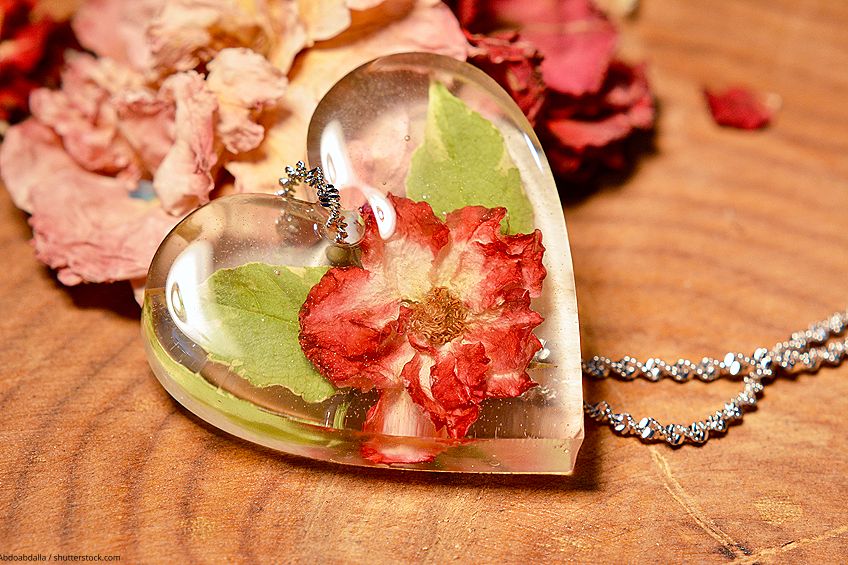
The Hairspray Method
An alternative option to seal your flowers is to spray then using any lacquer spray or hairspray, ensuring that you spray all sides of the flowers. This is a simple method to do and it will ensure that your flowers remain in their original shape. The downside is that it is a messy job, and you will be required to coat the flowers with several layers.
Results for Dried Flowers
- Daisies and Japanese Maple – The result will be very nice.
- Lilacs – The flowers will lose their volume but will retain their color.
- Buttercups – The flowers look nice but can become quite flat.
- Common Daisies – The petals will become very transparent and thin.
- Cherry Blossom – The spray causes the flowers to become fragile and brittle.
Results for Fresh Flowers
- Daisies and Japanese Maple – The spray causes the petals to become transparent.
- Lilacs – The flowers become one blob and are discolored and brown.
- Buttercups – The spray causes the petals to begin to crumble.
- Common Daisies – The spray causes the petals to stick together and become green in color.
- Cherry Blossoms – The spray causes the petals to stick together and become transparent.
Which Sealing Method is Best for My Flowers?
When sealing flowers before placing them in resin, the results are impacted by the type of flowers you are using as well as the type of resin you have selected. Some flowers will discolor and some will need a sealing coat. Thus, it might be necessary to test the different sealing methods on your selected flowers before you place them in resin so as to determine the best method.
- Daisies – Spray and glue methods will both alter the color of the flowers, so rather use the dried flower method.
- Lilacs – Use the dried flowers method.
- Japanese Maple – The dried flowers method is the best, but all the methods work out well.
- Buttercups – The dried flowers method is the best.
- Common Daisies – The best method is the fresh method.
- Cherry Blossoms – Use fresh flowers and seal with the glue method.
There is an additional method to seal your flowers, by using plastic laminating pouches or even clear tape, where you will place the flowers between two surfaces.
Preserving Fresh Flowers in Resin
It can be tempting to want to cast fresh flowers in resin so as to preserve their beauty and vibrant colors forever. However, as flowers are organic materials, they can become rotten within the resin if they are not properly dried first. Thus, you cannot simply set fresh flowers in resin, as you will end up with the following negative results:
- Daisies – The fresh flowers will become transparent.
- Lilacs – The resin will turn the flowers brown and discolor them.
- Japanese Maple – The thinner parts of the flower will start to curl up.
- Buttercup – Any pollen in the flowers will seep into the resin.
- Common Daisies – The petals will become transparent and lose all of their colors.
- Cherry Blossoms – The petals will begin to shrink when in the resin.
To avoid this from happening, you will need to dry your flowers before casting them in resin. Alternatively, you can spray your fresh flowers with hairspray so as to preserve them. You will need to try to keep your flowers as fresh as possible for as long as you can, which can be achieved by cooling them, placing them in your fridge for a few hours, or placing them in a dry, cool space.

How to Set Roses in Clear Resin
Roses are gorgeous flowers that should never be wasted. Ideally, you would like to be able to enjoy them for a longer time, so you should preserve your flowers in resin.
Dry Your Roses
- Select the roses you wish to preserve and ensure that they are not in full bloom, as this will help you keep the bright colors.
- Remove the majority of the leaves from the stems, but keep a few leaves as it creates a beautiful element to your design
- Wrap a piece of string around the stem of your rose, ensuring that it is tied tightly, and will not come loose.
- Hang your roses to dry, ensuring that you do not leave them in the direct sunlight. Drying can take 7 to 15 days. Be sure to check on them every few days.
- When the flowers are completely dry, you can take the bunch apart and cut the rose away from the stem. If you have chosen to use some of the leaves in your setting, you can remove them from the stems and set them in the resin with the flowers
- To ensure that the flowers are completely dry, you can place them in an oven for 2 to 3 hours (at 100 degrees Fahrenheit). Lay the flowers on a baking tray, placing them on the lowest rack in the oven.
- Alternatively, you can use a microwave to perform the final drying, which will save you a lot of time as you will only require 2 to 3 minutes. However, to use the microwave you will have to put the roses in silica gel or sand. If you have chosen to dry them in the microwave, you will need to allow them to sit and cool for at least 24 hours once removed.
Prepare the Resin
- The best resin to use is a clear polyester resin for casting, which will allow you to see your roses clearly when they have cured. However, this particular resin dries very slowly, although this can be a positive as it allows you plenty of time to arrange the flowers as you wish.
- If you are hoping to achieve a tinted finish, you will require an epoxy resin. This is a faster-drying type of resin and will last much longer than your polyester resins.
- Ensure that you are working in a well-ventilated area and using the necessary protective gear, including a respirator or mask, nitrile gloves, and goggles.
- Select the mold you are going to use, which can be silicone, latex rubber, or plastic. A flexible mold makes it easier to remove the resin once it has set. Determine the amount of resin you will require for your selected mold, and ensure you carefully follow the manufacturer’s instructions.
- Mix your resin and hardener in your mixing cups. Using a popsicle or craft stick, stir the two combinations until they are properly mixed.
Create Your Mold Item
- Pour your first layer of resin carefully into the mold.
- Place your roses and leaves onto the initial layer of resin, arranging them how you want.
- Allow this initial layer to dry until it is tacky to the touch before pouring the next layer.
- Carefully pour the rest of your resin over the roses, ensuring they are completely covered. If the roses begin to rise a little, that is not a problem.
- Allow the flowers and resin to sit for 10 to 20 minutes. At this stage, the resin should have started setting but will still be pliable. You can now push the roses back down into the resin if they have floated up so that they are sitting in the position you require.
- Allow the resin to cure for at least 24 hours, but if it is still sticky after this period, allow it to cure a little longer.
- When completely cured, you can remove the resin from the mold. If you have used a polished silicone mold, you will need to do very little with regards to sanding and polishing. Finally, allow 24 to 48 hours for the resin to completely cure.
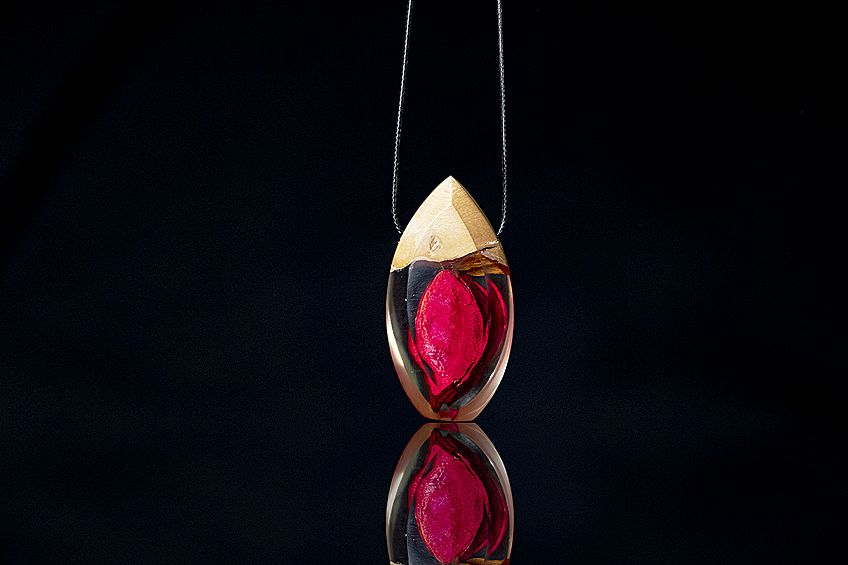
Frequently Asked Questions
Do You Have to Dry Flowers Before Putting Them in Resin?
Any moisture left in the flowers may result in the resin not curing properly, or in the flower rotting inside the resin over time. Thus, you should always ensure that your flowers are completely dry before adding them to resin, as otherwise they will turn brown.
Must You Seal Flowers Before Adding Resin?
While this step is not crucial, it can be helpful to add a protective sealant to your flowers to prevent them from reacting with the resin. You can do this with ease by coating the flowers a layer of clear drying glue that has been diluted with water.
How Can I Preserve the Color of My Dried Flowers?
You should aim to cut flowers just before they have bloomed in order to get the best, most vibrant color. Tie the flowers together in bundles and hang them up to dry in a dark and dry space. As light can cause colors to fade, you will get the best pigment by leaving the flowers to dry in a dark location. Blue and yellow flowers are especially good at maintaining their color when air-dried.
Larissa Meyer is a 32-year-old mother from Michigan and creative spirit since childhood. Her passion for painting and drawing has led her to an education as an illustrator and a career as a freelance graphic designer. She has a Bachelor of Fine Arts in Illustration and a degree in Graphic Design. Larissa is a talented artist who is able to master a wide range of styles and techniques to bring her artistic vision to life. Her greatest passion is currently fluid painting and epoxy resin art. As a mom of two kids, Larissa also understands the importance of fostering creativity in early childhood. She uses her experience and knowledge to help other parents inspire their children and develop their artistic skills as well.
Learn all about Larissa Meyer and Fluid Painting.

